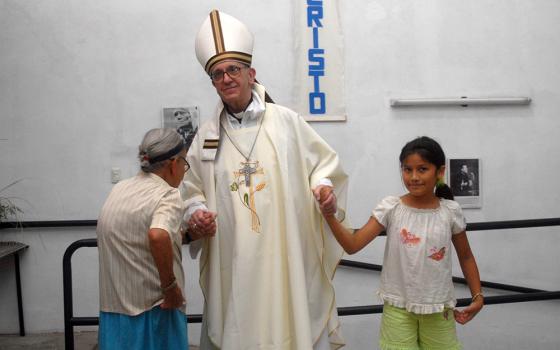
(Pixabay/ijmaki)
Monday was among the most disheartening days on Catholic Twitter that I have ever seen, if not the very worst. ("Catholic Twitter" isn't a specific site or brand, it’s just a collective term to describe Catholic people, publications and organizations that use Twitter — or who comment on Catholic things.)
After vandals entered a church in Rome and filmed themselves stealing and destroying a statue of a pregnant woman that has been used during indigenous people’s prayer services around the synod on the Amazon, radical traditionalist Catholics rushed to social media to praise the theft as a noble act, supposedly defending the church from pagan or satanic influence. (Never mind, as brand-new St. John Henry Newman pointed out, that the church has been incorporating cultural elements of various, even "pagan" origins since the very beginning.)
The NCR editorial board and other columnists here have responded thoughtfully from different perspectives to the shameful racist and sexist events of the week, but I want to talk specifically about Catholic Twitter, which facilitates the flow of hateful vitriol every day.
To orient the Twitter-less, Catholic Twitter is not unlike our big-tent church in some ways: different factions, different priorities, occasional moments of real prayer and mutual support and learning and beauty. You can interact with holy men and women and grow in virtue.
But in a few key ways, Catholic Twitter isn't the church at all. First, it's not an in-person experience, and users can hide behind pseudonymous usernames, which makes ad hominem insults far easier to dish out than they would be if you saw someone you disagreed with face-to-face. There is real, ugly, hateful stuff out there, often launched into cyberspace by those who justify it by positioning themselves as righteous soldiers in the orthodoxy wars. Any reference to Catholic Twitter as a "community," therefore, has to come with an enormous asterisk.
Second, Catholic Twitter attracts those with the sharpest opinions and loudest voices like moths to a porch light. Every conflict is heightened, every emotion intensified. The middle 90% of the Catholic bell curve is very lightly represented. Third, the combination of these first two characteristics makes Catholic Twitter a place of hate-reading and rubbernecking, as it's hard to fight the temptation to check in on the crazy thing your least-favorite blogger or faux-theologian said this morning. There's more of this behavior than real dialogue.
The question I've been wrestling with since Monday is, what should I do about it? I'm not an active Catholic Twitter combatant, but to borrow one of Thomas Merton's book titles, I'm a guilty bystander. I lurk, toss occasional passive-aggressive grenades out there, delete them. I do have some personal Catholic Twitter rules of engagement I've fallen into without much intention, and they seem to work pretty well in most instances. They let me participate at the fringes, trying to pull out the good stuff, without getting swept away in the torrent.
Advertisement
My first rule is to curate the feed carefully. There are really fantastic, informative Catholic Twitter accounts out there. They are nourishment for my faith. I find them and follow them. I do not follow others. The main downside of careful curation is that it's easy to turn my feed into an echo chamber, featuring only those I agree with on most topics. I try to let an account's tone and generosity of spirit lead my curation more than its view on women's ordination or guitar Masses, for example.
My second rule is to use the "mute" button liberally. Muting keeps certain angry folks off my feed without them knowing it. If Twitter lost the mute function, I'd delete it from my phone instantly and forever.
Third, in the words of Deadspin columnist Albert Burneko, it's OK to log off. I need to get out of there once in a while. Truthfully, I probably need to get out of there more often than I do. Putting my phone on a bookcase at home, out of my pocket, seems to help. Some of my favorite Twitter personalities deactivate their accounts for days or weeks at a time. I have not yet done this.
Fourth, borrowing from my friend Michael Bayer and others, I don't engage those with anonymous accounts. Any semblance of actual conversation on Catholic Twitter requires two real, accountable people.
Fifth, don't hit "tweet" on posts I wouldn't dare say in real life. Easy one. And a sixth and related one, always pray more and try to be more like Jesus in my online (and offline) interactions. Simcha Fisher took this up in her recent essay on the Amazon synod and the vandalism.
"Everyone wants to imitate Jesus in the one time He showed some temper with the whip in the temple. Dude, you are not Jesus," she writes. "It's a much safer bet to imitate Him in the other 99% of the Gospels, like when He preached the good news, when He fed His sheep, when he gave over His body, and when He fixed His eyes firmly on the Father and then told us to do the same."
That's good advice for us tweeters. Let's pray for the strength to follow it.
[Mike Jordan Laskey is senior communications manager for the Jesuit Conference in Washington, D.C. He is the author of The Ministry of Peace and Justice (Liturgical Press) and lives with his family in New Jersey.]
Editor's note: We can send you a newsletter every time a Young Voices column is posted to NCRonline.org. Go to this page and follow directions: Newsletter sign-up.







